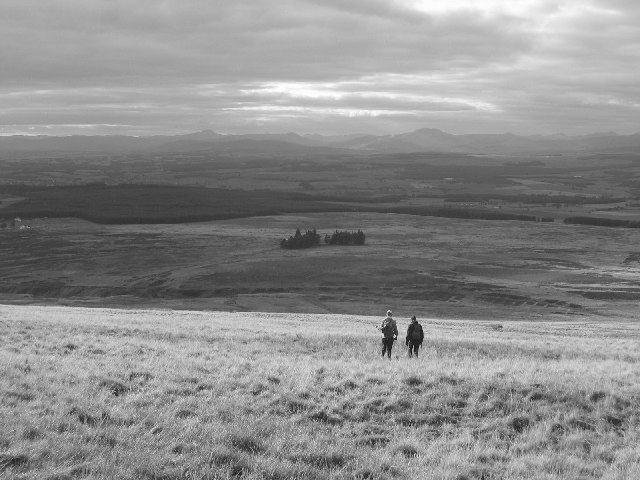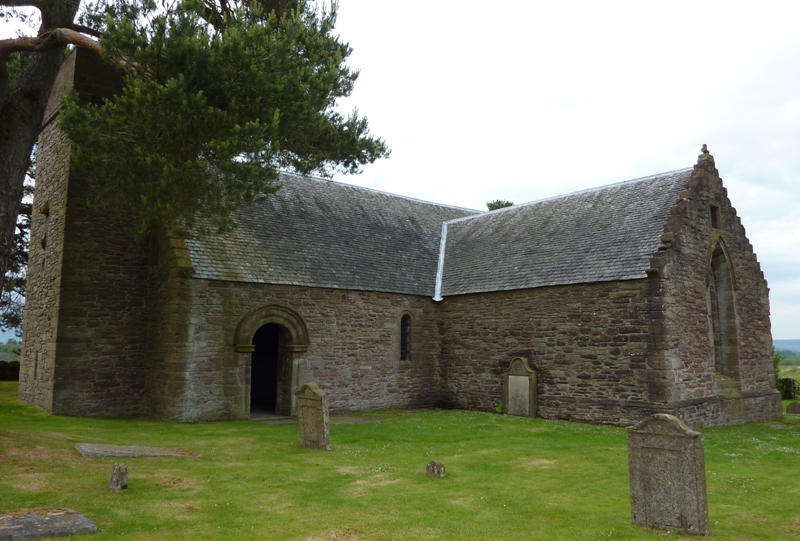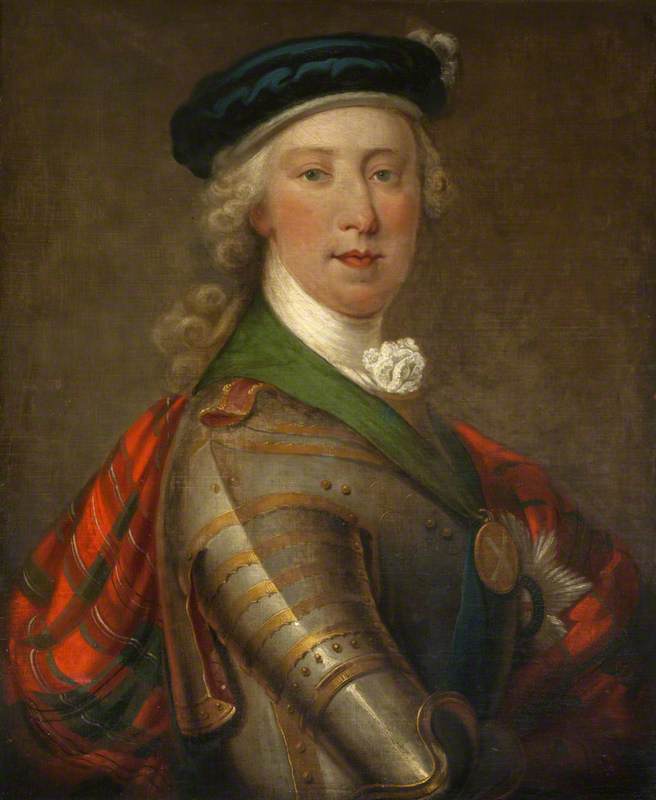|
Tullibardine
Tullibardine is a location in Perth and Kinross, Scotland, which gives its name to a village, a castle and a grant of nobility. The village of Tullibardine is a settlement of approximately forty dwellings about southwest of Perth. It lies in the parish of Blackford, and the nearest town is Auchterarder, to the south. Tullibardine Castle was a medieval fortification on a low eminence west of the village. Little is known about it and it no longer exists. The castle was built by the Clan Murray in the late 13th to early 14th century, after it had extended its holdings south from its heartland in Morayshire. The castle predates the nearby chapel, which is dated to 1446. The castle was dismantled in 1747, following the Jacobite rebellion, and was completely demolished in 1833. Tullibardine Chapel was built in the 1446 by David Murray of Tullibardine as a family chapel and burial site, and members of the Murray family were buried there until 1900. The chapel has remained unaltered ... [...More Info...] [...Related Items...] OR: [Wikipedia] [Google] [Baidu] |
Earl Of Tullibardine
Duke of Atholl, named for Atholl in Scotland, is a title in the Peerage of Scotland held by the head of Clan Murray. It was created by Queen Anne in 1703 for John Murray, 2nd Marquess of Atholl, with a special remainder to the heir male of his father, the 1st Marquess. , there were twelve subsidiary titles attached to the dukedom: Lord Murray of Tullibardine (1604), Lord Murray, Gask and Balquhidder (1628), Lord Murray, Balvany and Gask (1676), Lord Murray, Balvenie and Gask, in the County of Perth (1703), Viscount of Balquhidder (1676), Viscount of Balquhidder, Glenalmond and Glenlyon, in the County of Perth (1703), Earl of Atholl (1629), Earl of Tullibardine (1628), Earl of Tullibardine (1676), Earl of Strathtay and Strathardle, in the County of Perth (1703), Marquess of Atholl (1676) and Marquess of Tullibardine, in the County of Perth (1703). These titles are also in the Peerage of Scotland. The dukes have also previously held the following titles: Baron Strange ( Peerag ... [...More Info...] [...Related Items...] OR: [Wikipedia] [Google] [Baidu] |
Clan Murray
Clan Murray () is a Highland Scottish clan. The chief of the Clan Murray holds the title of Duke of Atholl. Their ancestors were the Morays of Bothwell who established the family in Scotland in the 12th century. In the 16th century, descendants of the Morays of Bothwell, the Murrays of Tullibardine, secured the chiefship of the clan and were created Earls of Tullibardine in 1606. The first Earl of Tullibardine married the heiress to the Stewart earldom of Atholl and Atholl therefore became a Murray earldom in 1626. The Murray Earl of Atholl was created Marquess of Atholl in 1676 and in 1703 it became a dukedom. The marquess of Tullibardine title has continued as a subsidiary title, being bestowed on elder sons of the chief until they succeed him as Duke of Atholl. The Murray chiefs played an important and prominent role in support of William Wallace and Robert the Bruce during the Wars of Scottish Independence in the 13th and 14th centuries. The Murrays also largely supported th ... [...More Info...] [...Related Items...] OR: [Wikipedia] [Google] [Baidu] |
William Murray, Marquess Of Tullibardine
William Murray, Marquess of Tullibardine (14 April 1689 – 9 July 1746) was a Scottish nobleman and Jacobite who took part in the rebellions of 1715, 1719, and 1745. Attainted for his role in 1715, his younger brother James succeeded as Duke of Atholl in 1724, although Tullibardine was made Duke of Rannoch in the Jacobite peerage. After the 1719 rebellion, he spent the next 25 years in France, where he lived in extreme poverty and seemed to have suffered from physical and mental illness. Nevertheless, he was one of the Seven Men of Moidart who accompanied Prince Charles to Scotland in July 1745, while another brother Lord George Murray served as a senior leader of the Jacobite army. Captured after Culloden in April 1746, he died in the Tower of London on 9 July. Personal details William Murray was born on 14 April 1689, at Huntingtower near Perth, Scotland, second son of John Murray, 1st Duke of Atholl (1660–1724) and his first wife, Katherine Hamilton (1662� ... [...More Info...] [...Related Items...] OR: [Wikipedia] [Google] [Baidu] |
Tullibardine Chapel 20090616
Tullibardine is a location in Perth and Kinross, Scotland, which gives its name to a village, a castle and a grant of nobility. The village of Tullibardine is a settlement of approximately forty dwellings about southwest of Perth. It lies in the parish of Blackford, and the nearest town is Auchterarder, to the south. Tullibardine Castle was a medieval fortification on a low eminence west of the village. Little is known about it and it no longer exists. The castle was built by the Clan Murray in the late 13th to early 14th century, after it had extended its holdings south from its heartland in Morayshire. The castle predates the nearby chapel, which is dated to 1446. The castle was dismantled in 1747, following the Jacobite rebellion, and was completely demolished in 1833. Tullibardine Chapel was built in the 1446 by David Murray of Tullibardine as a family chapel and burial site, and members of the Murray family were buried there until 1900. The chapel has remained unaltered ... [...More Info...] [...Related Items...] OR: [Wikipedia] [Google] [Baidu] |
Tullibardine Castle
Tullibardine Castle was a castle located in the village of Tullibardine, north of Auchterarder in Perth and Kinross, Scotland. History The lands of Tullibardine passed to the Murray family after Ada de Strathearn, the wife of William Murray, was granted the other moiety of Tullibardine from her aunty. The castle was built in the late 13th to early 14th century, with likely its first custodian being David Murray, Baron of Tullibardine.''Sharpe's Peerage of the British Empire exhibiting its present state and deducing the existing descents from the ancient nobility of England, Scotland and Ireland'', Volume 1, John Sharpe (1830) One early Murray owner of the castle was said to have had seventeen sons. The king thought he had broken the law by having an armed retinue. The brothers were said to have slept in a large round room in the castle, their heads placed against a central pillar. The outline of the ship, the ''Great Michael'', commissioned by James IV, was commemorated by a ... [...More Info...] [...Related Items...] OR: [Wikipedia] [Google] [Baidu] |
Lord George Murray (general)
Lord George Murray (4 October 1694 – 11 October 1760), sixth son of John Murray, 1st Duke of Atholl, was a Scottish nobleman and soldier who took part in the Jacobite rebellions of Jacobite rising of 1715, 1715 and Jacobite rising of 1719, 1719 and played a senior role in that of Jacobite rising of 1745, 1745. Pardoned in 1725, he returned to Scotland, where he married and in 1739 took the oath of allegiance to George II of Great Britain, George II. When the 1745 Rising began, Murray was appointed sheriff principal, sheriff depute to John Cope (British Army officer), Sir John Cope, government commander in Scotland but then joined the Jacobite army when it arrived in Perth, Scotland, Perth on 3 September. As one of the senior commanders, he made a substantial contribution to their early success, particularly reaching and successfully returning from Derby. However, his support for the Acts of Union 1707, 1707 Union set him apart from the majority of Scottish Jacobites, and pre ... [...More Info...] [...Related Items...] OR: [Wikipedia] [Google] [Baidu] |
Tullibardine Chapel
Tullibardine Chapel is an ancient church building in Tullibardine, Perth and Kinross, Scotland. It is one of the most complete medieval churches in Scotland. A large part of it dating to 1446, it is now a scheduled monument.Tullibardine Chapel, chapel 100m W of West Mains of Tullibardine – The chapel was built by Sir (formerly of |
Jacobite Rising Of 1719
The Jacobite Rising of 1719 was a failed attempt to restore the exiled James Francis Edward Stuart to the throne of Great Britain. Part of a series of Jacobite risings between 1689 to 1745, it was the only one to be supported by Spain, then at war with Britain during the War of the Quadruple Alliance. The main part of the plan called for 5,000 Spanish troops to land in South West England, with a subsidiary landing in Scotland by an expeditionary force, led by Charles XII of Sweden. To facilitate this, Scottish Jacobites would capture the port of Inverness; however, Charles' death in November 1718 ended Swedish involvement, and the purpose of the Scottish rising. In late March, a small force of Spanish marines and Jacobite exiles landed in Stornoway, where they learned the Spanish invasion fleet had been severely damaged by storms, and the invasion of England cancelled. The Rising ended with defeat at the Battle of Glen Shiel in June. Jacobite leaders felt the revolt actively dam ... [...More Info...] [...Related Items...] OR: [Wikipedia] [Google] [Baidu] |
Lilias Grant
Lady Lilias Grant (''née'' Murray d. 1643/4) was a Scottish letter-writer and matriarch of the Grant clan of Freuchie. Family background Lady Lilias Murray was the second daughter of Sir John Murray of Tullibardine, Master of the King's Household, who in 1606 was created Earl of Tullibardine, and his wife, Catherine Drummond, daughter of David Lord Drummond. According to the titles of poems by James VI, her sister Anne Murray was the king's mistress. Wedding at Tullibardine The marriage-contract of Lilias Murray and John Grant Laird of Freuchie was dated at Gask on 15 April 1591. An eighteenth-century author Lachlan Shaw stated that King James the Sixth and his Queen attended the marriage. James attended and performed in a masque with his valet, probably John Wemyss of Logie. They wore Venetian carnival masks and helmets with red and pink taffeta costumes, made by the Edinburgh tailor Alexander Miller. The queen, Anne of Denmark went on to Perth alone, where on 29 June sh ... [...More Info...] [...Related Items...] OR: [Wikipedia] [Google] [Baidu] |
Tullibardine Railway Station
Tullibardine railway station served the town of Tullibardine, Perth and Kinross in Scotland. History It was built in 1857 for the Crieff Junction Railway, which connected the town of Crieff , six miles to the north, with the Scottish Central Railway at Crieff Junction (now Gleneagles). The CJR was absorbed by the Caledonian Railway in 1865, which itself became part of the London, Midland and Scottish The London, Midland and Scottish Railway (LMSIt has been argued that the initials LMSR should be used to be consistent with LNER, GWR and SR. The London, Midland and Scottish Railway's corporate image used LMS, and this is what is generally u ... in 1923. The line and the station were closed as part of the Beeching closures in 1964. References Disused railway stations in Perth and Kinross Beeching closures in Scotland Former Caledonian Railway stations Railway stations in Great Britain opened in 1857 Railway stations in Great Britain closed in 1964 {{ ... [...More Info...] [...Related Items...] OR: [Wikipedia] [Google] [Baidu] |
Blackford, Perth And Kinross
Blackford (Scottish Gaelic: ''Srath Gaoithe'') is located in Perth and Kinross, Scotland, approximately from the town of Auchterarder. The village is located just off the A9 between Perth and Stirling which has been bypassed since 1978. It is home to Highland Spring water and the Tullibardine whisky distillery. Prehistory Archaeological work between 2006-08 ahead of the development of a golf course found extensive remains of prehistoric settlements. The settlements were dated to the Middle and Late Bronze Age, with some continued habitation into the Early Iron Age. Most of the structures were probably roundhouses, some were enclosed by palisades, possibly for defense. These communities made their living from a mixed farming economy, with some craft production. History Blackford was first known as a ford over the Allan Water. There is a legend that a King Magnus lost his wife Queen Helen in a storm and she is buried on a nearby hill. Blackford became a popular stopping pla ... [...More Info...] [...Related Items...] OR: [Wikipedia] [Google] [Baidu] |




